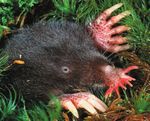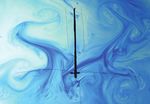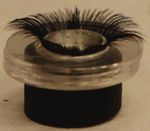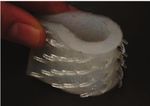SECOND NATURE - Sara Goudarzi
←
→
Page content transcription
If your browser does not render page correctly, please read the page content below
SECOND
NATURE
David Hu refines the art of observation to turn animal abilities into elegant
engineering solutions. BY SARA GO UDA RZI
Reprinted with permission, Mechanical Engineering magazine Vol. 141, No. 4, April 2019. Copyright ASME 2019.
0419_MEM_FEA_Second Nature.indd 36 3/5/19 10:47 AMMECHANICAL ENGINEERING | APRIL 2019 | P.37
W
hen his daughter was born, fluid dynami- that all animals weighing more than 3 kg (6.6 pounds) uri-
cist David Hu was astonished at the length nate for approximately 21 seconds, no matter their body size.
of her eyelashes. The fact that the newborn That finding, published in the Proceedings of the National
was otherwise hairless prompted him to Academy of Sciences earned him a 2015 Ig Nobel prize, rec-
find out why we have these hairs at the edge of our eyelids to ognizing “research that makes people laugh and think.” Get
begin with. No one had an answer. So Hu and his colleagues past the chuckle, and the implications of the paper are pro-
at Georgia Institute of Technology in Atlanta set out to mea- found: Nature uses gravity in a way to optimize a necessary
sure the eyelashes of 22 mammals. task without wasting energy, a discovery that could advance
What they found out was that the length of eyelashes is water systems like fire hoses, water tanks, and water-filled
roughly one-third the width of the mammalian eye. backpacks.
They then devised mockups of the eye by building a wind For Hu, who runs a biolocomotion laboratory at the Geor-
tunnel that could blow air past a cup of water with eyelashes gia Tech where he is an associate professor of mechanical en-
on its rim. That length of one-third the eye’s width reduced gineering and biology, animals are the key to discovering new,
evaporation of the cup’s water by a factor of two—essentially physical ways of dealing with the world—to learning how to
helping keep the eyes moist by reducing the airflow. Shorter accomplish difficult tasks that many life forms undertake very
lashes failed at properly blocking the air and longer ones efficiently like moving around, eating, drinking, storing and
actually directed more airflow to the eye. releasing waste, and keeping things clean.
Similar circumstances—an incident where his infant son “We try to identify the few real champions, animals that are
urinated on him during a diaper change—led Hu to discover really typifying optimal ways to do these processes,” Hu said.
Reprinted with permission, Mechanical Engineering magazine Vol. 141, No. 4, April 2019. Copyright ASME 2019.
0419_MEM_FEA_Second Nature.indd 37 3/5/19 10:47 AMThe idea falls in line with the principle popularized by Massachusetts Institute of Technology in Cambridge, Hu’s
physiologist August Krogh in 1929, which states that for many undergraduate advisor was Lakshminarayanan Mahadevan,
tasks there will be one or more animals in nature that could be a mechanical engineer who used math to describe natural
used as models. processes. Furthermore, there was renewed interest in that
“Evolutionary history provides a phenomenal and very field: In classes they studied termite mounds and plants, and
long-duration testing ground for all kinds of environments and professors showed students mechanical devices that were
uses for systems,” said Sheila Patek, associate professor of biol- designed to move like fish.
ogy at Duke University in Durham, N.C. “We see that revealed But it wasn’t until after working for an oil company and
through the spectacular diversity of systems around us.” returning to school for graduate studies in the early 2000s that
Hu really began to focus on this field. It started as a homework
WALKING ON WATER assignment on how water striders walk on water for John
Hu has been studying the intersection between engineer- W.M. Bush, professor of applied mathematics at MIT and an
ing and natural systems for most of his career. As a student at expert in surface tension.
Reprinted with permission, Mechanical Engineering magazine Vol. 141, No. 4, April 2019. Copyright ASME 2019.
0419_MEM_FEA_Second Nature.indd 38 3/5/19 10:47 AMMECHANICAL ENGINEERING | APRIL 2019 | P.39
speed photography coupled with flow-visualization technol-
ogy, they saw that water strider legs never actually break the
water surface. Instead, they row across it.
“Once we had them [waterstriders] in the lab, we were able
to quickly validate our view that they were shedding vortices
with each leg stroke, thereby resolving a paradox in the biolo-
comotion literature,” Bush recalled.
Chan, with the help of Bush and Hu, then designed a ro-
botic water strider, Robostrider, to mimic what they learned.
“I believe that it was the first non-buoyant water-walking
device,” Bush said. “It has certainly spawned an entire genera-
tion of more sophisticated devices developed by engineers
along the same lines, the utility of which remains to be seen.”
The three detailed the findings in a paper for Nature, and
Hu turned it into his doctoral thesis.
At Georgia Tech, Hu is mostly focused on biomechanics
of animal locomotion. A lot of his work, centered on every-
day wonders that many might not stop to consider, can aid
researchers in developing robots and other useful devices.
He has tried to popularize some of these findings in his book,
How to Walk on Water and Climb up Walls: Animal Movements
and the Robotics of the Future.
But the down-to-earth focus of his research has drawn
not just gentle ribbing, like the Ig Noble Prize, but outright
scorn. Former United States Senator Jeff Flake, for instance,
included three of his projects as part of a top 20 list of wasteful
federally funded science undertakings.
Many scientists are likely to take issue with such criticism.
David Hu studies “There is also a long history of extraordinary discoveries
animals to learn how from everyday phenomena and our surrounding biological
they have evloved
world,” Patek said. “We wouldn’t be flying around in airplanes
to meet physical
challenges. Here, he without that kind of initial fascination and inspiration. I’ve
examines how mosquito found that folks who make that argument often just aren’t
wings react to dew; the aware of the necessary and integral interplay of basic and ap-
wing folds in response
plied research.”
to the surface tension
forces of the drop.
Photo: Candler Hobbs CATALOGUE OF WONDERS
Although Hu responded directly to Flake via an Emory
University TEDx talk, it’s his work, whose applications are
Bush remembers Hu as playful and fun to work with. forthcoming, which are perhaps the appropriate response to
“I also appreciated his resourcefulness and tenacity,” Bush this type of criticism.
said. “When I suggested the water strider problem to him, For instance, Hu, researcher Alexis Noel, and their col-
the first thing he did was to go hunting for water striders at a leagues recently looked at the structure of cat tongues, which
nearby pond.” are known for being sandpapery rough. The research team
Researchers believed that water striders were able to walk discovered grooves in the millimeter-tall spikes on the top
on water by making waves that help push them forward. That of the tongues that enable them to pick up saliva. As a cat
led to a mystery first identified by Stanford biologist Mark grooms, the saliva is spread through the fur to the skin, essen-
Denny: Young water striders couldn’t move their legs fast tially washing both.
enough to create the waves necessary to walk on water. But “People have looked at cat tongues before and no one
they could, so how did they do it? observed they have this particular shape,” Hu said. He credits
When Bush, Hu, and mechanical engineering graduate stu- the use of 3-D scanners and printers to spot the structures and
dent Brian Chan studied water striders in the lab using high- verify their purpose.
Reprinted with permission, Mechanical Engineering magazine Vol. 141, No. 4, April 2019. Copyright ASME 2019.
0419_MEM_FEA_Second Nature.indd 39 3/5/19 10:47 AM1 2
1. STRIDER: To verify their hypothesis that insect
4
legs row across water, Hu and his colleagues built a
wire-legged robot that could duplicate the feat. 2. EYE-
LASHES: Hu’s lab devised a physical model to see how
well lashes of different lengths succeed at keeping wind
off the eye to reduce evaporation. 3. CAT TONGUE:
Felines of all sizes, including tigers, have tongues
covered with bristles. Hu's team discovered that the
spikes contain channels that wick saliva, helping clean
fur and skin. They’ve used the insight to create a special
hairbrush. 4. STAR-NOSE MOLE: By blowing bubbles
and sucking them back in, moles can smell under water.
Hu's lab created a star-shape device connected to an
electronic “nose” to see if the process could be adapted
for underwater sensing. Images: MIT (1); Georgia Tech (2-4)
Hu and his colleagues are now working on a patent for a Just drop food in a bin of larvae and some will be well-fed
cat-inspired hairbrush that would help pet-owners with aller- while others will struggle. By observing their behavior and
gies for whom there are currently few solutions. creating models that simulate the larvae eating habits, Hu
“This hairbrush, designed based on a cat’s tongue, can hopes to better understand how to feed and mix them, turn-
remove some of the allergens on cat fur,” Hu says. “There’s no ing maggot farm operation into a conveyor belt of insects so
way we could’ve designed that unless we looked at animals.” there won’t be any blockages, or traffic jams.
A large personal care company has already expressed His team is also studying the star-nosed mole, an almost
interest in the product. completely blind mammal that has evolved a way to hunt
Another research project involved studying the feeding underwater by sense of smell. The mole will breathe out a
habits of maggots in containers. bubble—a bit like a four-year-old with a cold—and then in-
A startup founded by Georgia Tech students raises black hale it back before it pinches off and floats away. The bubble
soldier fly larvae, Hermetia illucens, to quickly consume food captures chemical traces of the surrounding water and alerts
waste. The hope is that the larvae could consume some of the the mole to any nearby prey.
1.3 billion tons of food waste produced worldwide each year, Figuring out how the mole accomplishes this task could
and that the well-fed larvae could then become high-protein help technologists develop new types of underwater sensors,
feed for fish, chicken, and other livestock. which are currently prone to biofilm formation: a surface
“It’s a really novel way to deal with the waste problem,” growth of algae or bacteria that is especially common in
Hu said. ocean water.
The problem is figuring out the optimal way to get the “We believe that this underwater sniffing technique could
wasted food to the larvae. The larvae eat in five-minute circumvent the problem entirely,” said Alexander Bo Lee, a
bursts, and while they are feeding other hungry maggots are doctoral student in quantitative biosciences at Georgia Tech
pushing to get a bite, much the way pigs jostle at the trough. who works with Hu. “It would employ a gas sensor that never
Reprinted with permission, Mechanical Engineering magazine Vol. 141, No. 4, April 2019. Copyright ASME 2019.
0419_MEM_FEA_Second Nature.indd 40 3/5/19 10:47 AMMECHANICAL ENGINEERING | APRIL 2019 | P.41
3
touches the water. Instead, a bubble would sniff in and out to star glued to the end. The hope is to learn what happens as the
probe the water for chemicals and transfer them to the sensor. bubble is exhaled and inhaled at different rates and in bursts.
Without any contact with the water, bacteria and algae can’t One of the big factors in how animals sense their
form biofilms on the gas sensor.” environment through odor is that they don’t use continuing
The team suspected that the star shape of the mole’s nose motion, Hu explained. “When you have dirty gym socks
was a key factor in the stability of created bubbles. They you don’t smell continuously, you exhale and inhale, in
watched videos of the mole and noticed that it also tilts its short bursts.” The goal of the star-and-nose experiment is to
body side to side when blowing bubbles. So they built and understand the fluid mechanical consequences of having
tested devices that look like a mole’s nose. this type of airflow, one that the mole is able to achieve well
“The experiment involved mimicking the star-shaped under water.
geometry by laser-cutting plastic stars,” explained Lee, who For Hu, the world is one large catalogue of wonders, with
was the first author of a paper on the research that was pub- inspiration at every corner. All one has to do is look, find an
lished in Physical Review Fluids. “We then formed a bubble exemplary organism, mimic, and build upon its mechanisms.
against the stars. We found that the fins of the star prevent “It is a quintessential human activity to see what other
the bubble from rising, but the gaps in between the fins play organisms can do and then wonder whether we, as humans,
a role in preventing the bubble from sliding off the star when could build something new or achieve some new capability,”
the entire system is tilted. Bubbles rising through the gaps of Patek said. “Biological systems have been around for much
the star act as counterweights, keeping the bubble centered longer than humans and they reflect a massive ‘database,’ if
on the nozzle.” you will, of inspiration.” ME
While that first set of experiments focused on static bubble
stability, the team is now looking at the dynamics of oscillat- SARA GOUDARZI is a Brooklyn-based writer whose work has appeared in Scientific
ing bubbles using an “artificial nose” olfactory sensor with the American, BBC Future, and Demand.
Reprinted with permission, Mechanical Engineering magazine Vol. 141, No. 4, April 2019. Copyright ASME 2019.
0419_MEM_FEA_Second Nature.indd 41 3/5/19 10:47 AMYou can also read



























































